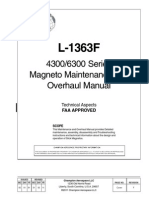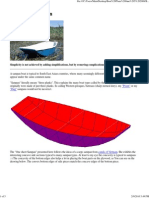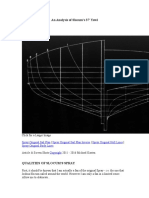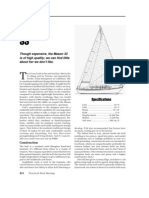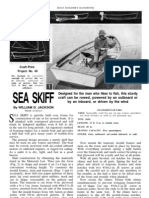3sd Free Boat Plans
3sd Free Boat Plans
Uploaded by
leather_nunCopyright:
Available Formats
3sd Free Boat Plans
3sd Free Boat Plans
Uploaded by
leather_nunOriginal Title
Copyright
Available Formats
Share this document
Did you find this document useful?
Is this content inappropriate?
Copyright:
Available Formats
3sd Free Boat Plans
3sd Free Boat Plans
Uploaded by
leather_nunCopyright:
Available Formats
3SD | Free Boat Plans
1 of 15
http://koti.kapsi.fi/hvartial/3sd/3sd.htm
Since I published the plans of the Little sister dory in 2003, I've been thinking about even better use of plywood.
My aim has been producing dory plans, that would produce a good looking dory, that would be as big (in terms of length and displacement) as three sheets of plywood would make possible, and
would make as nearly 100 % use of plywood as possible. Remember, I started this hobby with the one sheet design concept Prism, that makes a full 100 % use of a single sheet of plywood.
So here it is now. A new dory design, 3SD, standing simply for "Three Sheet Dory" (or "three standard deviations", meaning that this dory is that far from an average three sheet dory, that
seems to be a tiny 15' 6" or so boat ;-).
Be that as it may, this dory reaches about 91.9 % plywood utilisation. When You cut three sheets of plywood according to these plans You are left with so little waste plywood, that You can't
even make oar blades out of it.
I call that economical and ecological.
2/16/2012 11:11 PM
3SD | Free Boat Plans
2 of 15
http://koti.kapsi.fi/hvartial/3sd/3sd.htm
In my opinion the 3SD is good looking. Some might argue, however, that she has too much of sheer "for modern taste".
That may be so, but the strong sheer can be seen as traditional. In the following line drawing the profile of the 3SD is compared with the 1884 Portsmouth U.S. Navy shipyard dory presented by
John Gardner in his "Dory Book".
The green lines are those of the 3SD profile.
The blue lines are those of the 3SD profile scaled up a tiny bit to match the overall length of the 1884 Navy dory (18' 10").
The red lines are those of the 1884 U.S. Navy dory.
Overlaying the lines seems to indicate that the 3SD has less sheer than it could have, and still be called "traditional".
2/16/2012 11:11 PM
3SD | Free Boat Plans
3 of 15
http://koti.kapsi.fi/hvartial/3sd/3sd.htm
To tell You the truth, the strong sheer is a consequence of keeping the top of the boat side completely straight when flat ;-)
And I want to keep the flat side piece as straight-sided as possible. To avoid unnecessary lofting, cutting and waste plywood.
Two ways of building this boat are presented.
Butted sides and bottom, where pieces are connected with fiberglass tape butt joints. This way of building produces a 17' 8" (5.4 m) boat.
Scarphed sides and bottom, where pieces are scarphed together using 3" (76 mm) scarph joints. As this method of building "wastes" some of the total plywood length in the scarphs, the
boat produced will be slightly shorter, 17' 1" (5.2 m).
The pieces for a butted boat are cut out of three sheets of plywood like this.
2/16/2012 11:11 PM
3SD | Free Boat Plans
4 of 15
http://koti.kapsi.fi/hvartial/3sd/3sd.htm
The green pieces present the right, starboard side of the boat, the inner face up. Piece number 1 is the bow piece, number 2 is the middle piece, and number 3 is the stern.
The red pieces present the left, port side of the boat.
The yellow pieces make the bottom.
And the transom is laminated out of the two grey pieces.
Note, that the plywood sheets 1 and 2 are mirror images of each other, so they can be cut together in one go. If you do that, take care that the sheets are extremely well bonded together
so that they have no change of slipping relative to each other while making the cuts.
The transom pieces are displayed in a position for best grain alignment, grain running along the middle of the transom. In case you want to use a clear finish. For an opaque finish it would
be one cut less to cut the pieces in such a way, that one side of the transom lies along the plywood edge. Also leaves you with slightly larger left over pieces, maybe useful for something.
Oar blades, for example.
The pieces for the scarphed version correspond to the ones for the butted version, except for the provisions for the scarph joints.
The bright yellow zone indicates the area where wood is removed on the upper, visible surface of the plywood.
The vertical lines near the left edges of the individual sheets indicate the area where wood is removed from underneath the plywood.
Note: The sides are assembled "one side of the plywood out, one side in". In case Your plywood has one good and one bad side, You can have the inside of the boat all good, or the outside of
the boat all good, depending on Your taste. I'd probably have the good side in, because that's the side I'd be looking at most of the time. The fish may look at the bad side.
Measurements for the left boat side, inner side up. This would correspond to the red pieces of the above picture, the pieces connected. The plywood seam lines are indicated with blue vertical
lines on the drawing.
2/16/2012 11:11 PM
3SD | Free Boat Plans
5 of 15
http://koti.kapsi.fi/hvartial/3sd/3sd.htm
The plain measurements are for the butted version, the measurements in parentheses for the scarphed version.
Measurements for the boat bottom. The plain measurements are for the butted version, the measurements in parentheses for the scarphed version.
2/16/2012 11:11 PM
3SD | Free Boat Plans
6 of 15
http://koti.kapsi.fi/hvartial/3sd/3sd.htm
You may have noticed, that the sides and the bottom were both symmetric end to end. Just for simplicity :-)
Measurements for the transom. The plain measurements are for the butted version, the measurements in parentheses for the scarphed version.
2/16/2012 11:11 PM
3SD | Free Boat Plans
7 of 15
http://koti.kapsi.fi/hvartial/3sd/3sd.htm
Measurements for frames.
2/16/2012 11:11 PM
3SD | Free Boat Plans
8 of 15
http://koti.kapsi.fi/hvartial/3sd/3sd.htm
The angle of the stem is 63 degrees at the sheer, tapering to 42 degrees at the bottom.
2/16/2012 11:11 PM
3SD | Free Boat Plans
9 of 15
http://koti.kapsi.fi/hvartial/3sd/3sd.htm
Compare these with the resistance curves of the original Little sister dory. The wave
making resistance is lower now, so the new 3SD should be slightly lighter to row at speeds
above 3 knots or so.
Rt (violet curve) = total resistance
Rv (red curve) = viscous resistance (friction)
Rw (blue curve) = wave forming resistance
Rh (pale blue curve) = resistance created by transom stern
Full speed scale = 4.0 m/s = 14.4 km/h = 9.0 mph = 7.8 knots
2/16/2012 11:11 PM
3SD | Free Boat Plans
10 of 15
http://koti.kapsi.fi/hvartial/3sd/3sd.htm
The building sequence is roughly like this:
Cut the sides, bottom and transom out of plywood.
Cut a stem out of suitable wood.
Do the butts or scarphs, and laminate the transom.
Mark the frame position lines A, B and C on the inside of the sides and bottom.
Connect the sides to the stem at the bow.
Build the frames A, B ja C out of plank.
Glue and screw the middle frame B between the sides in such a way, that the line B on both boat sides coincides with the middle of the frame.
Connect the stern ends of the sides to the transom.
Insert frames A and C between the sides.
At this point do not attach frames A and C permanently. This is just a temporary arrangement to measure the angle of the sides at the frames to make a good fit.
Position the frames A and C in such a way, that the front frame A is just behind the line A (red in the drawing), rear frame C is just ahead of line C (red in the drawing).
Measure the distance between the frame and the side (blue arrows).
Transfer the measurement over to the other side of the frame (green arows).
Remove frames A and C.
Cut off the marked (orange) part of the frames.
Note, that the frames (yellow) have been drawn unnaturally wide, to make the drawing intelligible. With unnaturally wide frames it is obvious that the method of "moving the measurement over
to the other side" is not mathematically absolutely correct. But with normal sized frames the error is negligible. Besides, You don't need to hit planet Neptun with this...
Attach the chamfered frames permanently.
The front frame A in front of line A (red), the rear frame C behind line C (red).
2/16/2012 11:11 PM
3SD | Free Boat Plans
11 of 15
http://koti.kapsi.fi/hvartial/3sd/3sd.htm
Attach the bottom.
Attach risers inside the frames, for seats to rest on.
Attach seats and oarlocks.
Paint her.
Use her.
The 3SD is primarily suitable for one to three people. Using more than three seats makes good sense, however.
For best directional stability in windy conditions it is often best to have the boat:
Slightly bow-heavy rowing against the wind. The slightly raised stern acts as a wind vane helping to keep the bow into the wind.
Slightly stern heavy when going with the wind or wind on the side.
When rowing with the wind this loading keeps the bow from diving into the back of waves.
When rowing in a side wind, the combined forces of the wind and the boat movement through water tend to try to turn the boat into the wind. The stern heavy position acts to
ovecome this tendency.
The more seats You have, the more possible loading combinations.
2/16/2012 11:11 PM
3SD | Free Boat Plans
12 of 15
http://koti.kapsi.fi/hvartial/3sd/3sd.htm
A suitable oar length for both suggested oarlock positions would be in the range 8' 4" (2.5 m) to 8' 10" (2.7 m).
A quick and dirty prototype was built. Not by myself, but someone wanting to build a "quick-and-easy to build" boat for himself to use for fishing as long as a boat built that way would last.
2/16/2012 11:11 PM
3SD | Free Boat Plans
13 of 15
http://koti.kapsi.fi/hvartial/3sd/3sd.htm
As can be seen a prototype boat yard does not need to look much like a boat yard :-)
No saw horses, just a couple of garden chairs, and a couple of short lengths of two by four.
Probably a better way of building would be to build the frames first, then attach the sides to the frames and
transom, then add the bottom. As described above.
2/16/2012 11:11 PM
3SD | Free Boat Plans
14 of 15
http://koti.kapsi.fi/hvartial/3sd/3sd.htm
The plywood hull completed.
Frames inserted into the complete plywood skin.
But as written, this is probably not the best building sequence.
2/16/2012 11:11 PM
3SD | Free Boat Plans
15 of 15
http://koti.kapsi.fi/hvartial/3sd/3sd.htm
The hull from another angle.
"There's no picture of the finished boat" the prototype builder told me.
"I was in a hurry, and had to leave. Building took three long days altogether for one man."
"The boat gave a nice ride, it was very light to row. The strong head wind I had during the maiden voyage did blow the boat around a bit when I was alone in the boat. There was, however, no
fear of capsize."
Well, yes, that's the flip side of light displacement, shallow draft and light rowing. There is very little lateral resistance to the wind.
Add more weight or add an external keel. Both would add lateral resistance. But at the expense of shallow draft and light rowing.
Boatbuilding is nothing but compromises ;-)
Top of the page.
Back to main page.
2/16/2012 11:11 PM
You might also like
- X42002.Continental Ign - MagnetoDocument140 pagesX42002.Continental Ign - Magnetoleather_nun100% (11)
- An A Capa Metric PlansDocument6 pagesAn A Capa Metric PlanslcortezbrNo ratings yet
- Pratt Whitney Wasp Manual PDFDocument353 pagesPratt Whitney Wasp Manual PDFleather_nun100% (2)
- Slick Mag Overhaul ManualDocument64 pagesSlick Mag Overhaul Manualleather_nun100% (3)
- Notice: Spira International, IncDocument2 pagesNotice: Spira International, Incidix bloodjackersNo ratings yet
- One Sheet SampanDocument5 pagesOne Sheet Sampanleather_nunNo ratings yet
- F-14 Park Jet (Assembly Drawing)Document2 pagesF-14 Park Jet (Assembly Drawing)John MondoNo ratings yet
- Micro Auray PuntDocument9 pagesMicro Auray PuntAlphamatrix01No ratings yet
- Barton Skiff... 15ft 4in, by 4ft 8in, by 650lbs Displacement Outboard SkiffDocument9 pagesBarton Skiff... 15ft 4in, by 4ft 8in, by 650lbs Displacement Outboard SkiffStanlei FernandaNo ratings yet
- A 12 FT Skiff - Free Boat PlansDocument1 pageA 12 FT Skiff - Free Boat PlansRicardo DiasNo ratings yet
- Le Ptit GrosDocument10 pagesLe Ptit GrosKeith Williams100% (1)
- Julie SkiffDocument4 pagesJulie SkiffDan100% (1)
- Herring SkiffDocument8 pagesHerring SkifflcortezbrNo ratings yet
- Polytarp Junk SailDocument10 pagesPolytarp Junk SailScott GieferNo ratings yet
- Yurt DoorsDocument1 pageYurt DoorsAnthony GreenNo ratings yet
- A Runabout Reborn - Fast Modern Schooner - Lapstrake Primer: The Magazine For Wooden Boat Owners, Builders, and DesignersDocument152 pagesA Runabout Reborn - Fast Modern Schooner - Lapstrake Primer: The Magazine For Wooden Boat Owners, Builders, and DesignersPablo Besser100% (1)
- Strip PlankingDocument5 pagesStrip PlankingJoao Calinho100% (1)
- ModularPDR PDFDocument32 pagesModularPDR PDFocolibriNo ratings yet
- Mistral HullDocument5 pagesMistral HullmikeNo ratings yet
- Coarse, Carp, Fly & Sea Fishing Tackle: Saturday 17th March 2018Document16 pagesCoarse, Carp, Fly & Sea Fishing Tackle: Saturday 17th March 2018Sorin MaleaNo ratings yet
- One OffarticleDocument6 pagesOne OffarticleBOREBGK100% (1)
- The Pippie Tender: Mike Waller Yacht Design PO Box 383 Morayfield Brisbane, QLD, AustraliaDocument0 pagesThe Pippie Tender: Mike Waller Yacht Design PO Box 383 Morayfield Brisbane, QLD, AustraliaacastromNo ratings yet
- DolphinDocument5 pagesDolphinAlphamatrix01No ratings yet
- ILUR - Plan 11 Rev 2 General Arrangement Plan Scale 1/15 19 June 2013 François Vivier Architecte NavalDocument1 pageILUR - Plan 11 Rev 2 General Arrangement Plan Scale 1/15 19 June 2013 François Vivier Architecte NavalGEORGE KARYDISNo ratings yet
- R GlouConstDocument4 pagesR GlouConstjucassabaoNo ratings yet
- PLANS Folding KayakDocument15 pagesPLANS Folding KayakecalzoNo ratings yet
- Alside Siding Trim and Accessory CatalogDocument48 pagesAlside Siding Trim and Accessory CatalogMirza SofticNo ratings yet
- Brando Plans-Instr DigitalDocument21 pagesBrando Plans-Instr Digital劉書良100% (2)
- CaballeroDocument3 pagesCaballeroNicoara VladNo ratings yet
- Kepler Bottom Bracket Friction Drive For Sale (Finally) - Endless SphereDocument34 pagesKepler Bottom Bracket Friction Drive For Sale (Finally) - Endless SpheregiacummoNo ratings yet
- TRIFECTADocument17 pagesTRIFECTASteven0% (1)
- Classic Entry BenchDocument5 pagesClassic Entry BenchO'Neil JonesNo ratings yet
- AWKDocument14 pagesAWKMcMgNo ratings yet
- Instruction SetDocument13 pagesInstruction SetanonannonanonNo ratings yet
- Canadian Metric StudyDocument2 pagesCanadian Metric StudyDanNo ratings yet
- Project PaltusDocument22 pagesProject PaltusJoao CalinhoNo ratings yet
- PaddlesFree PDFDocument0 pagesPaddlesFree PDFspaceskipperNo ratings yet
- Shrike Build Manual - English Revised 3rd December 2021Document59 pagesShrike Build Manual - English Revised 3rd December 2021Ronald ZezeanuNo ratings yet
- HowToBuildATimberOutriggerCanoe PDFDocument50 pagesHowToBuildATimberOutriggerCanoe PDFLuca Ronchiato100% (1)
- David de Lossy/Photodisc/Getty ImagesDocument15 pagesDavid de Lossy/Photodisc/Getty ImagesasiasiNo ratings yet
- Swinfield A.N. Boatbuilding GuideDocument60 pagesSwinfield A.N. Boatbuilding GuideMaxi SieNo ratings yet
- Winchelsea 2.2 Plans ManualDocument50 pagesWinchelsea 2.2 Plans ManualStephen SpicklerNo ratings yet
- Tender "Fritz": PlansDocument15 pagesTender "Fritz": Plansİspir YazılımNo ratings yet
- An Analysis of Slocum 37 YawlDocument14 pagesAn Analysis of Slocum 37 YawlMarian IgescuNo ratings yet
- Hmd19 StudyDocument4 pagesHmd19 StudykadoNo ratings yet
- Stitch and Glue 101Document54 pagesStitch and Glue 101Abu-Abdullah SameerNo ratings yet
- BG Yacht Design - Pantanal 25Document6 pagesBG Yacht Design - Pantanal 25Lord AlmightyNo ratings yet
- ILUR - Plan 04 Rev 3 Dimensions Stem and Transom (Clinker) Scale 1/10, 1/5 Et 1/2 29 January 2016 François Vivier Architecte NavalDocument1 pageILUR - Plan 04 Rev 3 Dimensions Stem and Transom (Clinker) Scale 1/10, 1/5 Et 1/2 29 January 2016 François Vivier Architecte NavalGEORGE KARYDISNo ratings yet
- Kiwi RacerDocument4 pagesKiwi Racercipx2No ratings yet
- 15 Foot SailboatDocument4 pages15 Foot SailboatAntónio OliveiraNo ratings yet
- (Swath) : Small Waterplane Area Twin HullDocument64 pages(Swath) : Small Waterplane Area Twin HullDin ThorpeNo ratings yet
- Understanding Boat Design 102 PDFDocument1 pageUnderstanding Boat Design 102 PDFŁukasz ZygielNo ratings yet
- Fao Buildin A Double Ended Cambodian Design PDFDocument27 pagesFao Buildin A Double Ended Cambodian Design PDFfridomeroNo ratings yet
- Mason 33 Practical ReviewDocument5 pagesMason 33 Practical ReviewManuelPérez-Sola100% (1)
- Understanding Boat Design 103 PDFDocument1 pageUnderstanding Boat Design 103 PDFŁukasz ZygielNo ratings yet
- Modular Puddle Duck RacerDocument32 pagesModular Puddle Duck RacerSam Damiano100% (1)
- Multi SkiffDocument6 pagesMulti SkiffScaramagnao Miao BauNo ratings yet
- A Light Sculling Training Boat PDFDocument8 pagesA Light Sculling Training Boat PDFLuis BraulinoNo ratings yet
- One Sheet Boat, - More Info On Boat Building - The PrismDocument26 pagesOne Sheet Boat, - More Info On Boat Building - The PrismJoe RowingNo ratings yet
- Two DoriesDocument10 pagesTwo DoriesAlphamatrix01No ratings yet
- A 15'8" Fishing Punt: Start of The DiscussionDocument21 pagesA 15'8" Fishing Punt: Start of The DiscussionArmando GumucioNo ratings yet
- SimboDocument8 pagesSimboAlphamatrix01No ratings yet
- Boat SchoolDocument61 pagesBoat Schoolbobudo50% (10)
- Crane Cam Scam Lobe Profile CatalogDocument68 pagesCrane Cam Scam Lobe Profile Catalogleather_nunNo ratings yet
- Epoxy Works 10Document24 pagesEpoxy Works 10leather_nunNo ratings yet
- Rowboat Sail ConversionDocument2 pagesRowboat Sail Conversionleather_nunNo ratings yet
- Build A Spillproof CanoeDocument6 pagesBuild A Spillproof Canoeleather_nunNo ratings yet
- How To Make Show CardsDocument128 pagesHow To Make Show Cardsleather_nun100% (4)
- 10 Yuloh Cheap IntroductDocument2 pages10 Yuloh Cheap Introductleather_nunNo ratings yet
- Farm Mechanics and Drawing For Secondary SchoolsDocument62 pagesFarm Mechanics and Drawing For Secondary Schoolsleather_nun100% (2)
- US Navy Course NAVEDTRA 14008 - Aviation Machinist's Mate 3 & 2Document286 pagesUS Navy Course NAVEDTRA 14008 - Aviation Machinist's Mate 3 & 2Georges100% (4)
- Seddon Basic Helicopter AerodynamicsDocument79 pagesSeddon Basic Helicopter Aerodynamicsleather_nun100% (3)
- Lycoming DirectDriveOverhaulDocument152 pagesLycoming DirectDriveOverhaulleather_nun100% (2)
- X30645 Tsio 360 OverhaulDocument208 pagesX30645 Tsio 360 Overhaulleather_nun100% (1)



